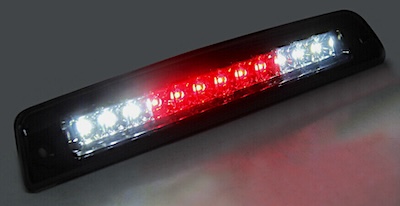Contents
The federal government expanded the third brake light requirement to include light trucks and vans in 1994. The extra light has been the law in the United States for nearly four decades. Since its implementation in the US, the European Union and Australia have adopted the standard, dubbed Center High Mount Stop Light (CHMSL).

Early studies found that rear-impact crashes dropped by more than 50 percent for fleet vehicles. Additional research by the National Highway Transportation Safety Administration (NHTSA) showed less dramatic results. Nonetheless, NHTSA found that CHMSL-equipped cars reduced rear impacts by 4.4 percent. That translates to reduced property damage by hundreds of millions of dollars annually.
Third Brake Light Placement
Initially, manufacturers were uncertain where to place third brake lights while maintaining a vehicle’s style. Today, rear lights have become integral to a car’s branding. Designers have fun with them, often adding signature design flourishes to a model.

CHMSL on a Jeep Wrangler
Many trucks and SUVs have the CHMSL installed along the edge of the cabin roof. Passenger cars often have the lights installed at the base of the rear window or higher up. Some Jeep models have them mounted above the spare tire holder. LED third brake lights sometimes combine with traditional rear and brake lights into playful shapes and patterns.
Adding a third brake light adds little cost to a vehicle’s price but dramatically enhances safety. The third brake light also provides redundancy. If one of the lower brake lights fails, the vehicle still has two points of illumination. Vehicles with robust diagnostics indicate when any of the three brake lights fail.
Shop now for third brake light assembliesHow to Add a Third Brake Light
If you own an older vehicle that lacks a third brake light, adding a CHMSL lamp is easy. While it may not be as stylish as the OEM-supplied version, it will be just as effective at warning other drivers and cost less than $50. Check your service manual for specific instructions and cautions.
Here are the basic steps to follow.
- Disconnect the battery first.
- Locate the power wire that is present at your existing rear brake light.
- Splice in a wire to this power source. Ensure the new spliced wire will reach the selected mounting point for your third brake light.
- Mount the CHMSL where it is visible, perhaps on the rear deck of a sedan or just below the top of the rear window glass.
- Connect the power wire to the fixture and ground the fixture to the car.
- Re-attach the battery and check the operation of the third brake light.
Replacing a Third-Brake Lamp
Accessing the brake lamps by removing the red lens is easy for most vehicles. The lens might be held in place with screws or by clips. After the lens is removed, you can replace the broken lamp.
Ensure that the replacement is an exact match with the existing bulb. Changing to a different bulb might cause electrical issues or produce insufficient light. Use gloves to avoid leaving any fingerprints or body oils on the bulb. The oils can prematurely burn out the bulb. If you have an LED fixture, you might need to replace the entire unit, depending on the vehicle’s make.
Shop now for third brake light assemblies





